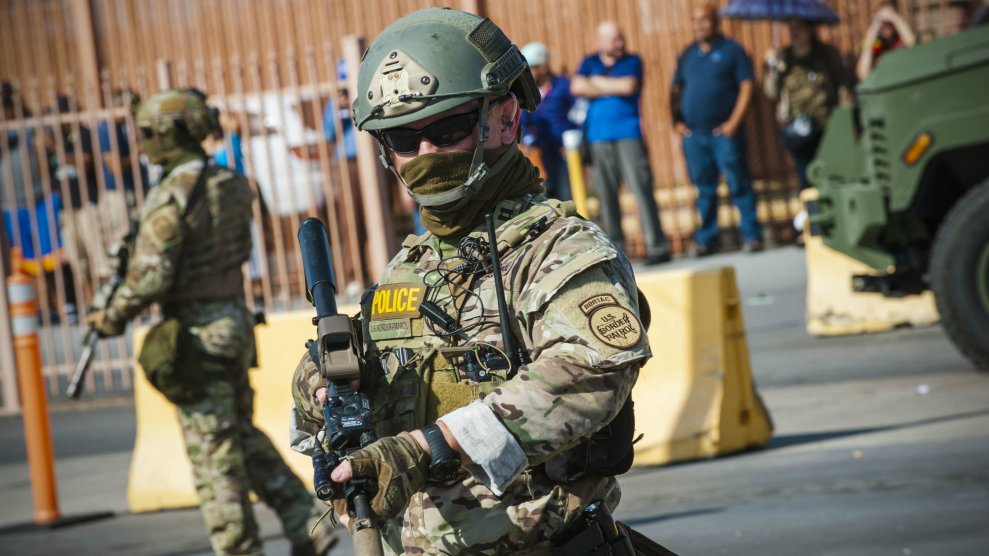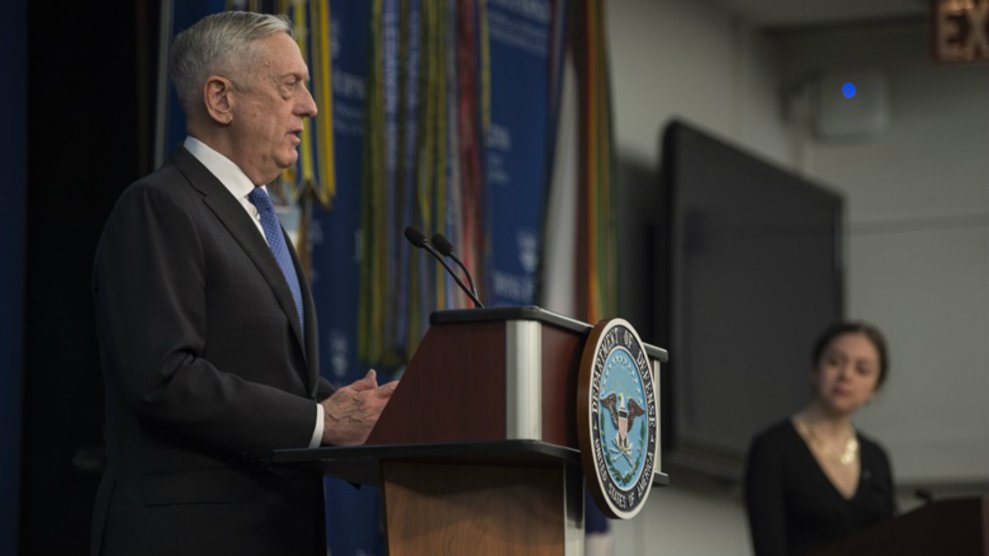
Andrew Cullen/AFP/Getty Images
The United States Department of Defense employs nearly three million people, but only nine of them are responsible for developing a suicide prevention strategy across the armed forces. They are the staff of the Defense Suicide Prevention Office, the crown jewel of an Obama-era effort to respond to the burgeoning suicide rate among active duty personnel and overhaul the way the military had historically addressed the problem.
With $20 million in funding allocated by Congress shortly after its founding in 2011 and a mandate to modernize the way DoD prevents suicide among active-duty service members, DSPO has found itself increasingly generating more turmoil than solutions. A nasty internal squabble three years after its inception between the founding director and Pentagon higher-ups resulted in an uncomfortable leadership transition and months of employee complaints. A series of unexecuted or discontinued contracts have hurt staff morale and drawn the ire of lawmakers. Annual reports have been sporadic.
For more than a year, the office has gone without a permanent director, cycling through a series of temporary leaders—none of whom had a background in mental health treatment or suicide prevention. Oversight from either Congress or the Pentagon has been sparse. By 2014, DSPO had already bounced between four different chains of command within the Pentagon’s unwieldy bureaucracy. Having been founded initially as a policy office, DSPO at one point was reporting up to DoD’s human resources directorate.
The installation of a permanent director in 2015 streamlined protocols and resolved tension with Pentagon higher-ups, but since Donald Trump took office, his administration has largely neglected this once-central office. Part of the problem has been the administration’s historically slow pace in submitting nominations for key government positions. Since winning the presidency, Trump has filled just 381 of the more than 700 government jobs requiring Senate confirmation, according to the Washington Post. Among these unfilled, or “gapped,” positions, are the top four civilian roles in the Office of Personnel and Readiness, which constitutes DSPO’s current chain of command. Three of those top P&R positions are temporarily being filled by acting directors.
Meanwhile, the suicide rate among active-duty service members has more than doubled between 2001 and 2016.
“We started this office to prevent suicide,” said Jackie Garrick, DSPO’s founding director who now runs an organization for whistleblowers. “I’d still like to see us follow through and actually prevent suicide.”
Shortly after Barack Obama took office in 2009, his Secretary of Defense Robert Gates commissioned a task force to study the alarming rise in military suicides since the start of the wars in Afghanistan and Iraq. From a rate of 10.3 suicides per 100,000 troops in 2001, the figure had climbed across the armed services to 18.4 in 2009.
That same year, the Army invited researchers to conduct an unprecedented study of mental health and resilience among more than 100,000 soldiers, which revealed that nearly half of all soldiers who have attempted suicide first did so before enlisting. “These results are a wake-up call highlighting the importance of outreach and intervention for new soldiers who enter the Army with pre-existing mental disorders,” co-principal investigator Dr. Robert J. Ursano said at the time.
After a year of work, the 14-member task force—divided equally between military officers and civilians—produced a 233-page report with 76 itemized recommendations. The first was to create a suicide prevention division within the secretary’s office that would “serve as a change agent” and “standardize policies and procedures with respect to resiliency, mental fitness, life skills, and suicide prevention.”
“The study, and its conclusions, were almost prima facie evidence that what we were doing in the Services wasn’t working,” Admiral Mike Mullen, then the chairman of the Joint Chiefs of Staff, told Mother Jones.
Garrick, a political appointee with a master’s degree in social work and experience at the Pentagon’s Office of Wounded Warrior Care and Transition Policy, was tapped to lead the newly formed office in November 2011. At the top of her agenda was creating a more collaborative approach among the Services, each of which had developed their own unique strategies, with varying degrees of success, to an issue that has bedeviled military leaders for generations. “Every Service level was doing something to prevent suicides. It was largely just uncoordinated,” said Bonnie Carroll, a member of the task force and founder of the Tragedy Assistance Program for Survivors, an organization that supports the families of slain service members.
As the founding director, Garrick with Army Lt. Gen. Michael Linnington, then the top-ranking military officer in the Office of Personnel and Readiness, convened periodic meetings with relevant leaders from the different branches of the armed forces to review suicide statistics and compare prevention initiatives. Nearly 900 different prevention programs existed at that point, and despite some successful outliers, many contained “inconsistencies, redundancies, and gaps in [their] approach,” Garrick later told Congress in a March 2013 hearing.
To resolve the problem, she came up with an “automated resource management tool” that would eliminate failing or unnecessary programs. One of the more troublesome policy differences among the Services was a lack of consistency as to who was responsible for actually reporting suicides. In one service, for instance, commanders were in charge of determining whether suspicious deaths qualified as suicides; in another, mental health providers or psychologists made the determination. The lack of consistency obstructed cross-military efforts to track and prevent suicide, according to Dr. Elspeth Cameron Ritchie, a retired Army colonel and psychiatrist with years of experience advising DoD on mental health issues.
The Services, each with their own colorful history and unique culture, have a “natural resistance” to policy discussions emanating from Pentagon bureaucrats, Mullen said. Garrick’s coordinated meetings were met with a similar skepticism. Attendance was spotty and no consensus emerged on a coherent prevention strategy, several attendees told Mother Jones. Without an ironclad directive from the Secretary of Defense’s office, none of DSPO’s ideas or instructions carried the weight of official department policy. Garrick’s team was supposed to provide the expertise that the Services lacked when dealing with complicated issues like brain trauma and resilience, but some crucial debates were never resolved.
Resilience, a wide-ranging idea that includes a mix of wellness and self-help strategies, was supposed to fall under DSPO’s domain, but military leaders each had their own conflicting definitions of what the topic meant, said Dana Whitis, who worked on resilience efforts within DSPO. “They have their own vision of what resilience is,” she told Mother Jones. “If you think resilience is more physical, you’re going to focus on gyms. If you think resilience is mental, you’re going to concentrate more on that.”
Compounding the problem was the influence of service members without a mental health background. Linnington, who currently heads the Wounded Warrior Project, acknowledged that in DSPO’s early days, “I lacked a professional background in resilience to adequately steer the efforts.” DoD has since launched a separate resilience office within the Office of Personnel and Readiness. But Pentagon spokesperson Maj. Carla Gleason wrote in a statement to Mother Jones, “In 2015, DSPO was reorganized and refocused to implement a holistic, public health approach to suicide prevention. While we no longer have a separate directorate for resiliency, we ensure resiliency is integrated across all of its suicide prevention portfolios.”
DSPO was not even working out of a government office for its first few year, but instead from an office building in Rosslyn owned by a Pentagon contractor. Lacking a consistent physical home, DSPO also bounced among organizational lines of authority, ultimately reporting to the Pentagon Human Resources division alongside the Defense Travel Management Office and the Office of the Actuary. DoD’s inspector general had determined that DSPO failed to standardize prevention policies across the Services and lacked any central mission. “There was no unified and coordinated effort to address suicide prevention across the DoD, and the Services continued to create their own Service-specific suicide prevention initiatives,” a report from the IG’s office concluded in September 2015. Suicide numbers among service members had declined since 2014 but still exceeded the number from 2011, the year Garrick took over. (Gleason noted in an email that because “the population demographics of the military and U.S. civilian communities are considerably different in terms of age and sex, a valid comparison of suicide rates needs to control for these differences. “If the military and U.S. population had the same age and gender distribution, there would be no significant difference between military and U.S. population suicide rates for calendar years 2011-2016,” she said.)
By December 2014, DSPO had failed to complete 21 of the 36 recommendations assigned to DoD by the original suicide prevention task force. That same month, Pentagon officials began planning a way to replace Garrick, according to emails obtained by Mother Jones. Eventually, after a complicated evaluation process, Garrick was told that she had been replaced by Dr. Keita Franklin who had been running the Marines’ behavioral health branch.
Internal emails also portray an awkward transition between Garrick and Dr. Keita Franklin. Garrick did not enjoy training her successor and the tension between Franklin and her became obvious to their supervisors. Virginia Penrod, formerly chief of staff to the undersecretary of defense for personnel and readiness, wrote in one email to other senior managers, “I believe it may be time to move [Jackie] if she can’t work in that space.” Garrick, for her part, attributed some frustration to the continuing lack of clarity regarding DSPO’s chain of command.
For a bureaucracy as sprawling as the Pentagon’s, it was perhaps inevitable that DSPO would be hobbled by unclear lines of authority and contradictory directives from management so soon after its formation. Three different bodies had some form of authority over the office’s operations: the Office of Personnel and Readiness, the Suicide Prevention and Risk Reduction Committee (SPARRC), and the Suicide Prevention General Officer Steering Committee (SPGOSC). These entities all were supervisory in nature but had conflicting areas of authority and, like DSPO, no clear mandate. One member of the steering committee called it a “joke” in an interview with Mother Jones.
In an attempt to address some of these problems—and to ward off heat from the IG report—DSPO under Dr. Franklin created a strategic plan as a guide through 2016, but the inspector general’s report noted that the plan “did not include timelines” and contained “no evidence in the plan of a direction for the future.”
“While I’d love to tell you that mental wellness and well-being and resilience are the top priorities for DoD, they are not,” said a former senior Pentagon official who interacted with DSPO. “It is, ‘Can they shoot? And if they can shoot, can they hit their target?'”
Another problem plaguing the office was budget uncertainty and mismanagement. After subsisting on a $6.9 million baseline budget—barely sufficient to pay for its signature programs, like a crisis hotline staffed by veterans—DSPO began increasingly relying on $20 million “adds” from Congress that had to be re-approved outside of the normal congressional appropriations process. Garrick directed these funds toward contracts for peer-to-peer hotlines, gunlock distribution programs, and a predictive analytics software to assess service members’ risk of suicide. All of these programs were discontinued by her successor, who several current and former DoD officials told Mother Jones imposed much-needed discipline and order in the office upon taking over.
The Institute for Defense Analyses, which released a 210-page report on DSPO in November 2016, reached a similar conclusion. “Our interviews show that stakeholders believe DSPO has become better focused since it began its second phase of operations in early 2015 under the leadership of a new Director,” the report stated. Whitis, the deputy resilience director, was shuffled off to another office after Franklin removed resilience from DSPO’s purview. She was initially asked to work on communications strategy, but felt dissatisfied with a policy that boiled down to asking people to call “a 1-800 number,” she said. She requested a transfer and ended up being assigned to the Defense Travel Management Office where she continues to work.
But some of Franklin’s early decisions rankled some staffers and flat-out enraged Garrick, who filed a series of internal complaints alleging that she was unfairly prevented from competing for her job. Among her complaints were allegations that Williams, the Pentagon official who emailed about Garrick’s behavior toward the newly-installed Franklin, had attempted to steer government funding from DSPO toward a friendly contractor and was biased in favor of Franklin. (Williams, who no longer works at DoD, declined to comment. Garrick ultimately settled with the Pentagon for an undisclosed amount and has applied to compete again for the job this year.)
Another controversial decision that Franklin made concerned the Vets4Warriors contract, which offered peer-to-peer counseling support to active-duty troops to the tune of $5.5 million per year. Franklin shifted the work, which was based out of Rutgers University, to another hotline, Military OneSource, citing a need to cut costs and streamline duplicative services. The decision led to sharp backlash from New Jersey’s congressional delegation, who wrote to then-Secretary of Defense Ash Carter, “We are concerned that … the trust in the confidential assistance provided by an organization like Vets4Warriors will be lost.”
“The Department determined that leveraging the Military OneSource call center for peer-to-peer support would improve service delivery, strengthen the continuity of care, and save money,” Gleason said. “The need to streamline call center efforts, enhance support to service members and their families, and ensure the military community has access to a portal for resources anywhere in the world drove this decision.”
During Franklin’s tenure, the Pentagon issued a Defense Strategy for Suicide Prevention and eventually made headway toward publishing a DoD Instruction, essentially an agency-wide directive to align the efforts of the Services with guidance from the Office of the Secretary of Defense, in this case around suicide prevention. The inspector general’s office had strenuously recommended that such a missive be issued. Even though it only was made public in November 2017, weeks after Franklin decamped to head up suicide prevention efforts at the Department of Veterans Affairs, her role in developing it was a key highlight of her stint at DSPO, where she won praise for bringing her experience in the Marine Corps to bear on dealing with the rest of the military. Several sources told Mother Jones her expertise was in high demand at the VA given an increase in veteran suicide rates and longstanding bureaucratic dysfunction within the department. Her role was only intended to last for a few months, but she ended up staying permanently.
Franklin did not respond to several requests for comment, including a detailed list of questions. A spokesperson for the VA declined to answer a series of questions about Franklin’s work at DSPO and referred comment to DoD.
Linnington, who knew of Franklin’s work from her time in the Marines, said that he could think of no one who “knows resilience, suicide prevention” better than she.
Since Franklin left for the VA after less than two years at DSPO, the vacancy has been filled by a series of acting directors. The Trump administration’s pace in filling key government posts means that DSPO has had virtually no oversight.
The Office of Personnel and Readiness that supervises DSPO has been substantially depleted in recent months. Once Robert Wilkie, the last permanent undersecretary of defense for personnel and readiness, was nominated to head the VA, Stephanie Barna became the sixth different person to lead the office in three years. Two other top positions, including the one Barna vacated, have been filled in a temporary capacity. (Gleason, the Pentagon spokesperson, said DoD is “in the process of assessing and interviewing the best qualified candidates” to take over the office.)
“If the Department of Defense thought it was a priority, they would have done something by now—but they have wars to fight,” a former senior DoD official said.
Seven years after its creation as a standalone office, DSPO still seems to be retracing its steps. Among the first things Garrick set out to do as director was evaluate suicide prevention programs across the military to eliminate redundancies, yet an official Pentagon document summarizing DSPO’s efforts said the office evaluated “all Service suicide prevention programs in 2018” and then “established a DoD wide metric model to evaluate suicide prevention efforts across the total force.” Garrick outlined this same plan in a report issued by DSPO in 2012 listing its annual activity, but no such report has been issued for five years, an oversight Gleason attributed to the office leveraging “other published documents such as the Quarterly Suicide Report, the DD Suicide Event Report, and our website to pass on suicide-related information.” Those quarterly suicide reports are at least two years behind schedule while DSPO’s social media presence—including a Twitter account with fewer than 600 followers—is limited at best. And, even as Congress has continued funneling more money toward the office, it still has just nine staffers, the same amount from Garrick’s first year as director.
Most importantly, the suicide rate among active-duty troops continues to rise. According to the most recent public figures, it is now at 21.1 deaths per 100,000 troops, a rate that is two-and-a-half percentage points higher than it was in 2011, the year DSPO was founded.
Correction: An earlier version of this story mistakenly noted a recent suicide rate being “21.1 percent per 100,000 troops” when it should have stated “21.1 deaths per 100,000 troops.” The article has also been updated to note that Dr. Keita Franklin worked in DSPO for less than two years, not “less than one year.”












